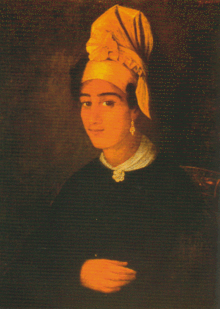Tignon

A tignon (also spelled and pronounced tiyon) is a type of headscarf, a large piece of material tied or wrapped around the head to form a kind of turban that somewhat resembles the West African gélé. It was worn by Creole women in Louisiana beginning in the Spanish colonial period, and continuing to a lesser extent to the present day.
This headdress was the result of sumptuary laws passed in 1785 under the administration of Governor Esteban Rodriguez Miró. Called the tignon laws, they prescribed and enforced appropriate public dress for female gens de couleur in colonial society. At this time in Louisiana history, women of color vied with white women in beauty, dress and manners. Many of them had become the placées (openly kept mistresses) of white, French, and Spanish Creole men. This incurred the jealousy and anger of their wives, mothers, sisters, daughters and fiancées. One complaint was that white men pursuing flirtations or liaisons sometimes mistook upper-class white women for light-skinned mixed-race women and accosted them in an improper manner.
To prevent this, Governor Miró decreed that women of color and black women, slave or free, should cover their hair and heads with a knotted headdress and refrain from "excessive attention to dress" to maintain class distinctions. But the women who were targets of this decree were inventive and imaginative. They decorated tignons with their jewels and ribbons, and used the finest available materials to wrap their hair. In other words, "[t]hey effectively re-interpreted the law without technically breaking the law"[1]--and they continued to be pursued by men.
The tignon can be wrapped in many ways, and it was and is worn in a different way by every woman. Madras was a popular fabric for tignons among both free and slave populations, and has become iconic. Tignons were often created out of mis-matched scraps of undyed fabric given to slaves by their masters. The patchwork of material was made appear festive. Tignons worn by free women of color or slaves in Louisiana and the Caribbean could be much more distinctive than those worn by American black slaves, and even had hidden messages.[2]
The tignon or gélé is experiencing a revival in American fashion. It is found particularly in Creole-themed weddings. Celebrities such as Erykah Badu and Jill Scott have revived it, transforming the controversial head-wrapping into a celebration of American culture.
Notes
- ↑ NPS Ethnography: African American Heritage & Ethnography
- ↑ The Tignon and Women of Color in Old New Orleans, African American Resource Center, New Orleans Public Library